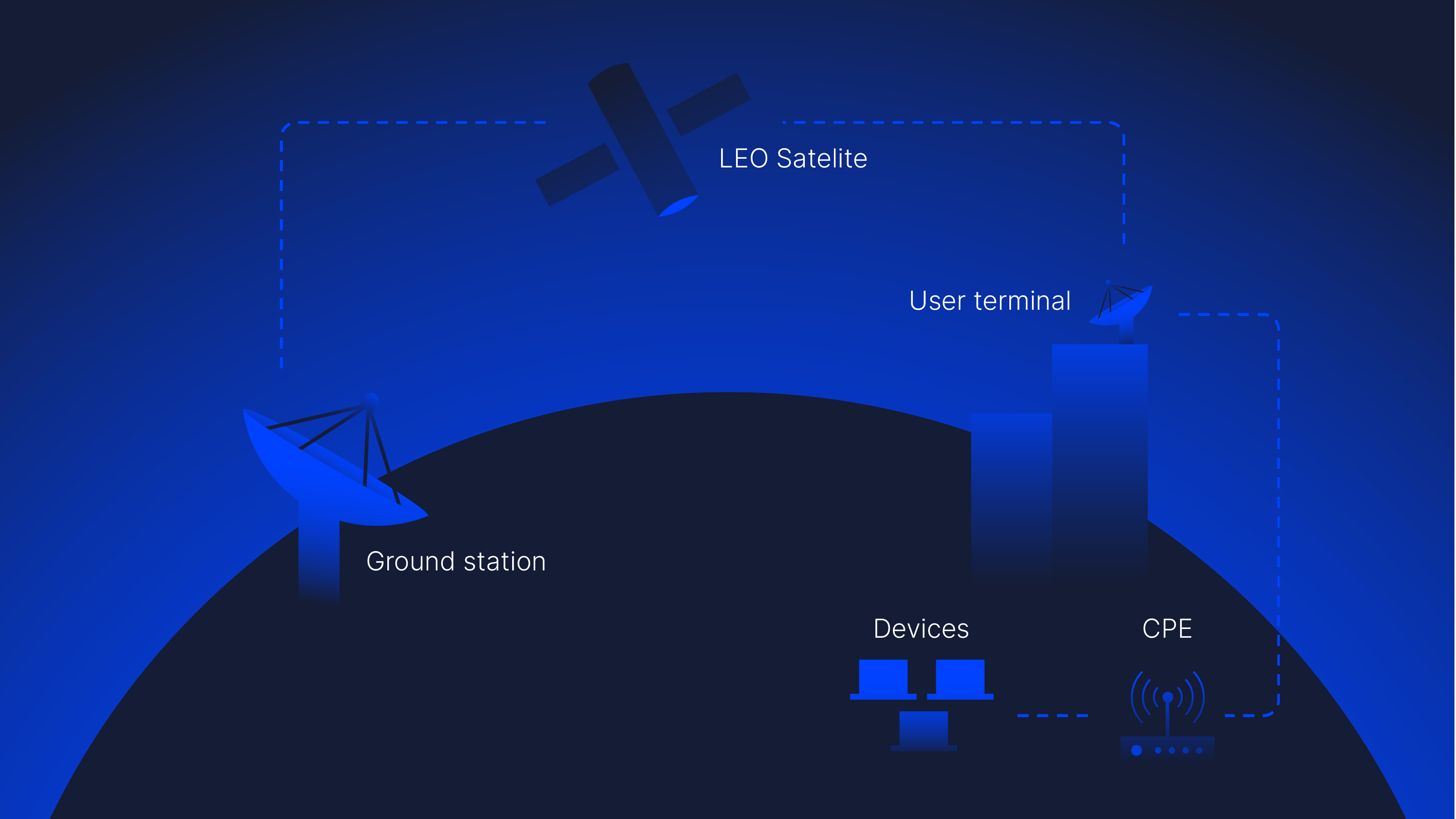Low-earth orbit (LEO) networks in your global connectivity strategy

In recent years, LEO-based networks have become a solid alternative in the enterprise connectivity landscape. The facts: better performance than traditional satellites, lower latencies, extensive coverage, and more accessible pricing for both consumers and businesses.
But how to get started in your LEO journey – and should you start such a journey? To help you out, we’ve put a quick guide covering:
- What is LEO (in a business WAN context)
- How it works, and ideal use cases
- Where to source it from
- A smooth start to your LEO journey
What is LEO (in a business WAN context)
LEO (low-earth orbit) satellites are a new generation of satellites, orbiting much closer to Earth—between 500 to 2,000 kilometers—than traditional geostationary (GEO) satellites, which hover at around 36,000 kilometers. This proximity is what gives LEO satellites its appeal to the enterprise, as it allows them to offer:
- Lower latency: With signals traveling shorter distances, latency can drop to as low as 20–40ms—rivaling LTE networks, and even wired networks (in some scenarios). This makes LEO satellites suitable for latency-sensitive applications like video conferencing.
- Higher bandwidth: Their proximity to Earth allows them to deliver faster and more consistent data speeds. This is good news for remote businesses that on bandwidth-intensive applications.
- Global coverage: Multiple investments in recent years have resulted in large “constellations” of LEO satellites providing connectivity in regions lacking terrestrial network infrastructure. This is particularly valuable for enterprises with operations in rural and hard-to-reach areas.
How it works, and what is it good for?
But how do you plug your enterprise into, well, the sky? Whether you are talking about Starlink, OneWeb’s SatOne, or ViaSat – among many others – the setup for LEO-based networks is very similar:

- User terminal (antenna): A satellite dish or antenna is mounted in an unobstructed location (like a rooftop or open area).
- Connection to Local Network: The user terminal plugs into an adapter that’s connected to your SD-WAN router, LAN switch, or another kind of CPE aimed to provide internet to your devices.
- Satellite Communication: The user terminal communicates with the nearest satellite overhead.
- Data Transmission: Data travels to/from the satellite to the closest ground station and then to the internet.
This simple setup gives LEO broadband the flexibility to move and bring connectivity to locations where traditional infrastructure—like fiber or fixed wireless—falls short.
Typical use cases
While fiber remains the preferred option for enterprises due to its overall performance, guarantees, and accessibility, the use cases for LEO-based connectivity continue to grow. Typical use cases we get:
Backup & SD-WAN Enhancement
Enterprises using SD-WAN can integrate LEO as a secondary or backup connection. It adds technology diversity and good bandwidth to a site. This makes it a good alternative to LTE/5G networks and ensures a redundant connection for always-on connectivity at your global operations.
Remote Sites
Oil rigs, mining operations, and sometimes even suburban areas lack the right infrastructure for business-grade connectivity. LEO broadband ensures these locations can get high-bandwidth connectivity to support their operations even at a large scale, supporting everything from IoT sensors to employee communications.
Maritime and Aviation
Traditionally, maritime and aviation had to rely on GEO satellites for their connectivity and communications, suffering from high latency and very slow speeds. Today, these industries can greatly improve their connectivity with LEO, improving safety and enhancing passenger and crew experience.
Sourcing LEO – the vendor landscape
Like with all connectivity options, LEO broadband is available for both consumers and businesses. Needless to say, if you are looking for enterprise-grade satellite networks, you should look to the same criteria you’d consider for any other connectivity alternative: availability, performance, SLAs, and support. Yes, you can get your LEO internet kit at the next gadget shop, but we suggest you look ‘a bit’ further.
How to source LEO connectivity for your business?
Hardware Resellers
These companies just sell the hardware kits (antennas, modems, etc.) you need for your LEO setup. However, they leave deployment, integration, security, and ongoing management to you. This option works best if you have the expertise and like tinkering with hardware or new technology.
Managed Service Providers
For a hands-off approach, managed service providers are your best option. They not only supply the hardware but also handle physical installation, deployment, testing, support, and day-to-day management. Providers like GNX offer end-to-end solutions, seamlessly integrating your LEO networks to your global WAN estate and ensuring you have expert support every step of the way.
A smooth start to your LEO Journey: GNX
As a technology- and carrier-neutral vendor, GNX helps you find the best connectivity options for your global business – whether this is a full LEO environment or a mix-and-match solution according to your sites’ diverse requirements.
What’s more, we help you along your entire journey, working with global and local ISPs in 190+ countries, managing your deployments, and providing 24/7 monitoring and support for the length of your contract. And yes, we are talking about one contract: for all your global sites, you’ll only get one contract, one monthly invoice, and one contact for your support needs. It is that straightforward.
Ready to take your connectivity to the next level? Let’s talk!

We are the leading provider of global internet and private connectivity solutions, here to guide you on your next steps. Get in touch with our team to learn more.


